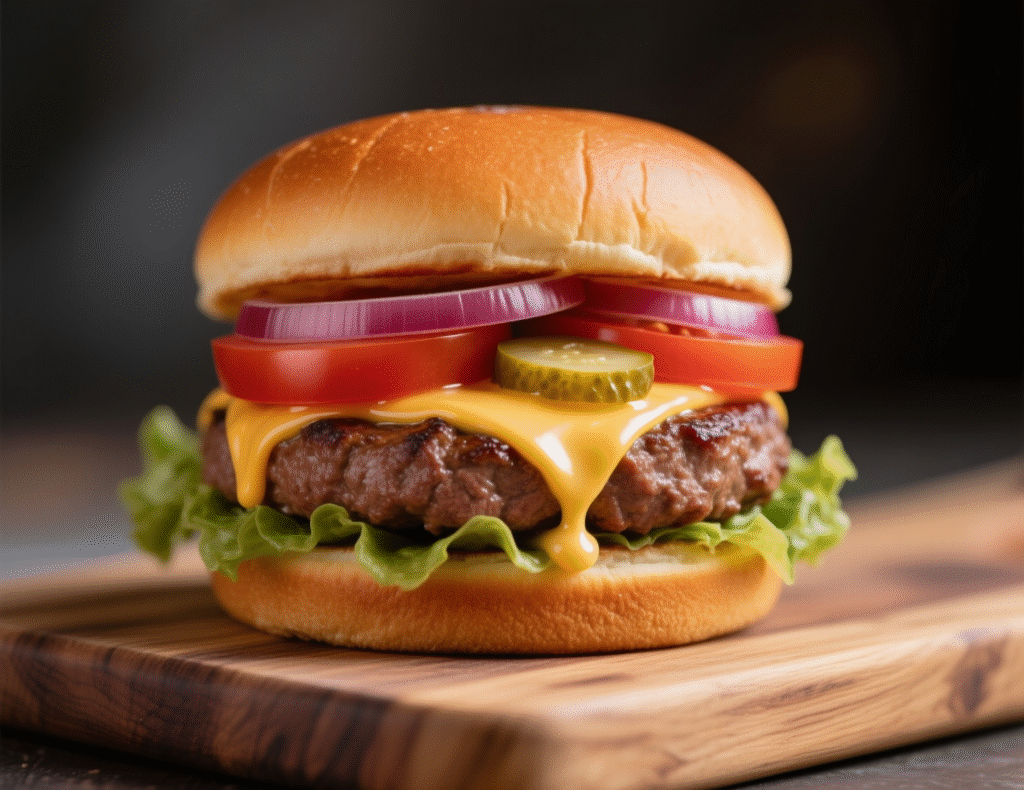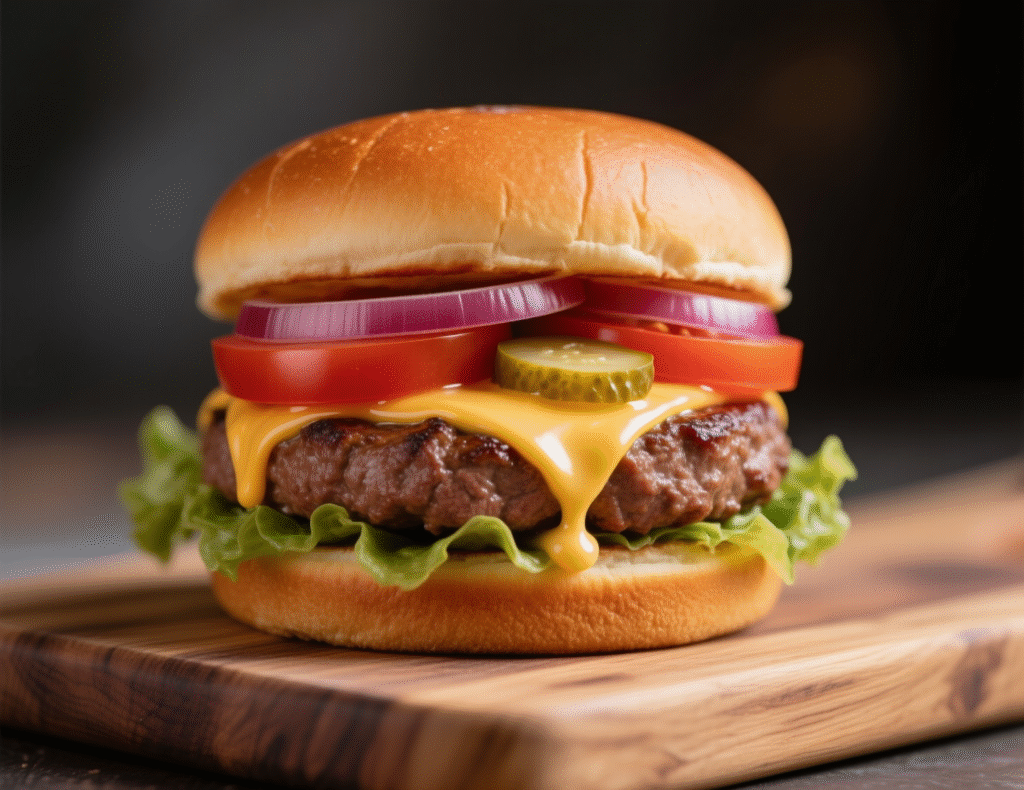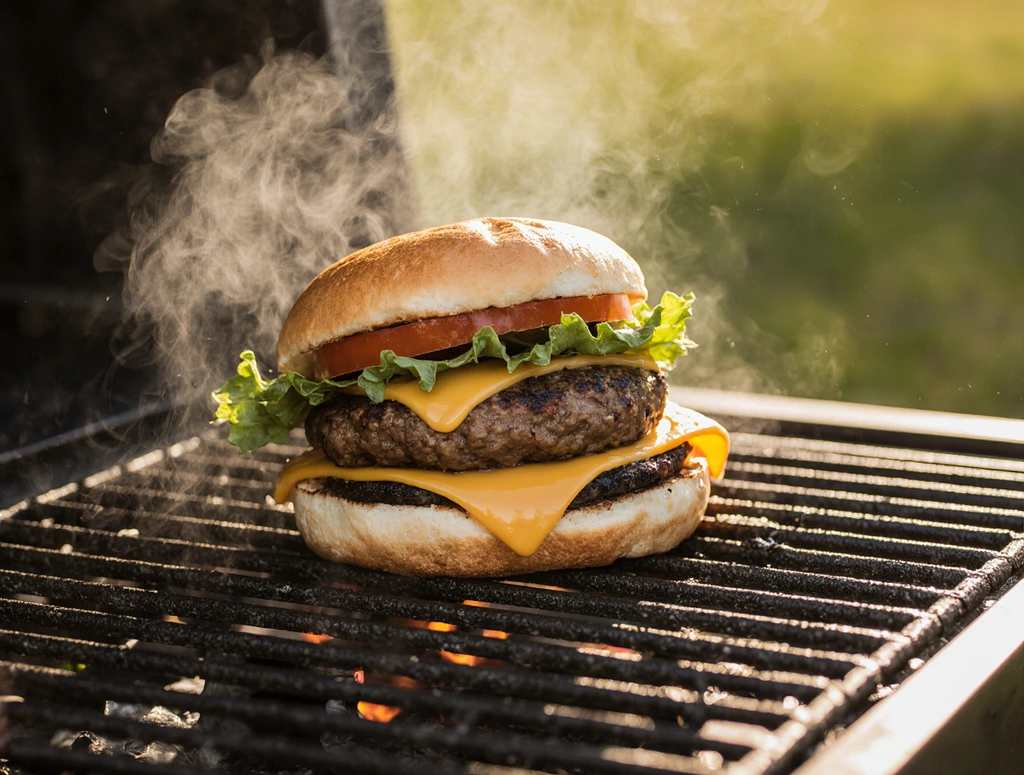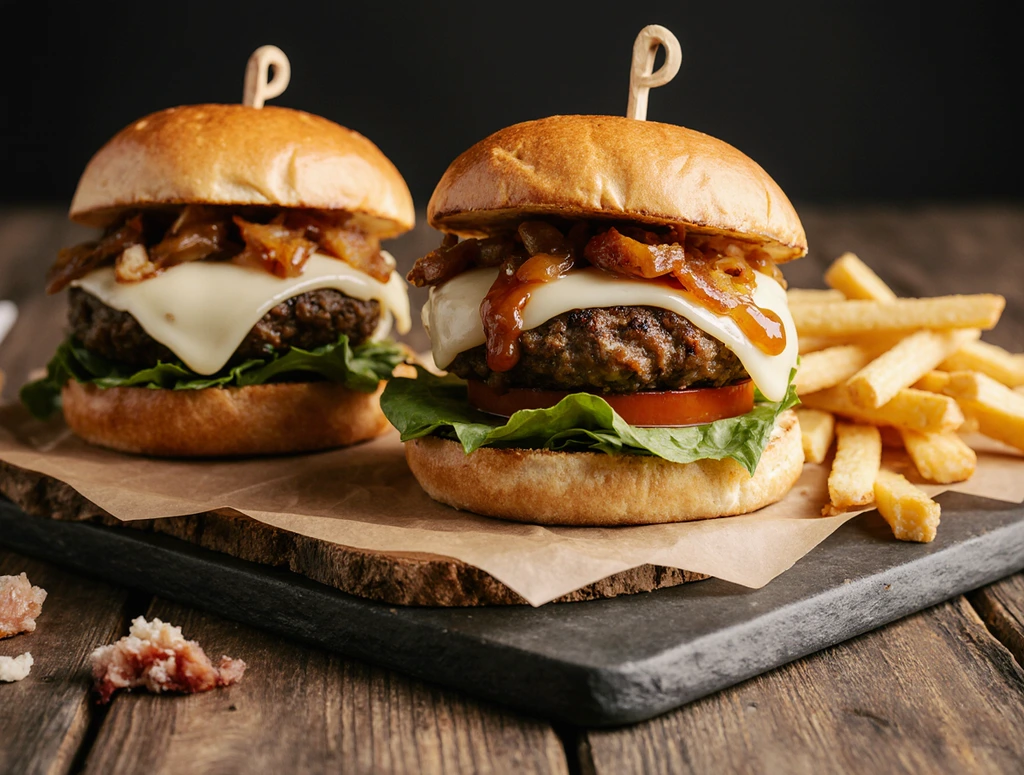
The Ultimate Cheeseburger Recipe Guide: Master Every Method
Hi, I’m Chef Hamza, and after 28+ years in the kitchen, I can tell you that mastering the perfect cheeseburger is both an art and a science. Today, I’m sharing everything I know about creating juicy, flavorful cheeseburgers that’ll make your taste buds sing—whether you’re grilling outdoors, cooking on the stovetop, or trying something completely new.
There’s nothing quite like sinking your teeth into a perfectly crafted cheeseburger. That first bite where the melted cheese mingles with a juicy patty, crisp lettuce, and tangy pickles—it’s pure magic. But here’s the thing: most home cooks are making critical mistakes that turn what should be burger perfection into a dry, disappointing mess.
In this comprehensive guide, I’ll walk you through every method for cooking cheeseburgers, share my secret techniques for keeping them juicy, and reveal the common mistakes that are sabotaging your burger game. Whether you’re a beginner looking for an easy cheeseburger recipe or an experienced cook wanting to perfect your homemade cheeseburger skills, this guide has you covered.
Table of Contents
- The Foundation: Choosing the Right Ground Beef
- Essential Cheeseburger Ingredients
- How to Cook Cheeseburgers on the Stove
- How to Grill Cheeseburgers
- Cast Iron Skillet Method
- Air Fryer Cheeseburgers
- Common Cheeseburger Mistakes to Avoid
- Best Cheese for Cheeseburgers
- Gourmet Cheeseburger Variations
- Perfect Burger Sauce Recipes
The Foundation: Choosing the Right Ground Beef
The secret to a juicy cheeseburger recipe starts with selecting the right ground beef. After decades of experimenting, I’ve learned that not all ground beef is created equal when it comes to burgers.
Understanding Fat Content: 80/20 vs Other Ratios
What is 80/20 ground beef? It’s ground beef with 80% lean meat and 20% fat—and it’s absolutely the gold standard for cheeseburgers. The fat content is crucial because it provides flavor, moisture, and that satisfying texture we all crave in a great burger.
Here’s how different fat ratios perform:
- 80/20 (Chuck): The perfect balance of flavor and juiciness. This is my go-to choice.
- 85/15: Acceptable but slightly less juicy. Good for those watching fat intake.
- 90/10 or leaner: Tends to produce dry, dense burgers. Avoid for cheeseburgers.
Chuck vs. Sirloin: Which is Better?
When grinding your own beef for burgers, chuck consistently wins over sirloin. Chuck comes from the shoulder area and has the ideal fat distribution and flavor profile. Sirloin, while leaner, lacks the fat marbling necessary for a truly exceptional burger.
Pro Tip from Chef Hamza: If you’re grinding your own beef, combine chuck roast with a small amount of short rib for an incredibly rich, flavorful patty that rivals any steakhouse burger.
Selecting Store-Bought Ground Beef
When purchasing ground beef, look for:
- Bright red color (not brown or gray)
- Fine, consistent grind
- Fresh “sell by” date
- Avoid pre-formed patties—they’re often made from lower-quality cuts
Want to track your burger’s nutritional content? Check out our calorie calculator to understand exactly what you’re consuming.
Essential Cheeseburger Ingredients
A classic cheeseburger recipe relies on quality ingredients working in harmony. Here’s what you need for my signature cheeseburgers:
The Basic Patty Mix
- 1 pound 80/20 ground chuck
- 1 teaspoon kosher salt
- 1/2 teaspoon fresh black pepper
- 1/2 teaspoon garlic powder
- 1/4 teaspoon onion powder
- 1 tablespoon Worcestershire sauce (optional, but recommended)
Essential Toppings
- 4 slices of your preferred cheese (American, cheddar, or Swiss)
- 4 hamburger buns (brioche or potato buns work best)
- Butter lettuce leaves
- Thick tomato slices
- Red onion rings
- Dill pickle slices
The key to exceptional burgers isn’t exotic ingredients—it’s using high-quality basics and treating them with respect.

How to Cook Cheeseburgers on the Stove
Stovetop burgers are my preferred method for consistent results, especially when cooking for a family. This technique gives you complete control over temperature and timing.
Equipment You’ll Need
- Large skillet (preferably cast iron)
- Wide, thin spatula
- Instant-read thermometer
- Paper towels
Step-by-Step Stovetop Method
Preparation (5 minutes)
- Remove ground beef from refrigerator 15 minutes before cooking
- Gently combine beef with salt, pepper, and seasonings
- Divide into 4 equal portions (about 4 ounces each)
- Form into patties slightly larger than your buns (they’ll shrink during cooking)
- Create a small dimple in the center of each patty to prevent bulging
Cooking Process (8-10 minutes)
- Heat your skillet over medium-high heat for 2-3 minutes
- Add a thin layer of oil or butter
- Place patties in the hot pan—they should sizzle immediately
- Cook for 3-4 minutes without pressing or moving them
- Flip once when you see juices pooling on top
- Add cheese immediately after flipping
- Cook for another 3-4 minutes for medium doneness
- Check internal temperature (160°F for well-done, 145°F for medium)
Chef Hamza’s Secret: I brush my buns with the rendered fat from the pan before toasting them. This adds incredible flavor and helps create that restaurant-quality experience at home.
Troubleshooting Stovetop Burgers
Why are my burgers dry? Usually due to overcooking or using too lean ground beef. Stick to 80/20 and don’t cook beyond 160°F internal temperature.
How to stop burgers from shrinking? The dimple technique helps, but some shrinkage is normal. Start with patties about 25% larger than your desired final size.
How to Grill Cheeseburgers
Grilling adds that unmistakable smoky flavor that makes cheeseburgers legendary. Whether you’re using charcoal or gas, the principles remain the same.

Charcoal vs Gas Grill: Which is Better?
Charcoal grills provide superior flavor due to the smoke and higher heat potential. However, gas grills offer better temperature control and convenience. For the best way to grill burgers, I actually prefer a hybrid approach: start with high heat for searing, then move to medium heat for cooking through.
Essential Grilling Setup
For Charcoal Grills:
- Create two heat zones: hot coals on one side, empty space on the other
- Target temperature: 400-450°F on the hot side
- Have a spray bottle for flare-ups
For Gas Grills:
- Preheat all burners to high for 10-15 minutes
- Create heat zones by turning one burner to medium after preheating
- Clean grates thoroughly with a grill brush
Step-by-Step Grilling Method
- Prep Your Patties: Form them the same way as stovetop method
- Oil the Grates: Prevent sticking by oiling grates with a paper towel dipped in neutral oil
- Sear First: Place patties over direct high heat for 2-3 minutes
- Flip Once: Move to medium heat zone and flip
- Add Cheese: Place cheese on patties immediately after flipping
- Finish Cooking: 2-4 minutes more depending on desired doneness
- Rest: Let burgers rest for 2 minutes before serving
Pro Grilling Tip: Toast your buns cut-side down on the cooler part of the grill for the last minute of cooking. This prevents them from getting soggy and adds texture.
Cast Iron Skillet Method: The Game-Changer
Cheeseburgers in cast iron skillet might just be the ultimate indoor cooking method. Cast iron provides superior heat retention and creates an incredible crust that’s impossible to achieve with other pans.
Why Cast Iron Works So Well
Cast iron skillets conduct heat evenly and efficiently, creating that coveted Maillard reaction that develops deep, complex flavors. The naturally non-stick surface (when properly seasoned) prevents sticking while allowing for perfect browning.
The Cast Iron Technique
Equipment Setup:
- 10-12 inch cast iron skillet
- Minimal oil (cast iron needs very little)
- Medium-high heat setting
Cooking Process:
- Preheat Thoroughly: Heat your cast iron for 3-4 minutes before adding patties
- No Oil Needed: Well-seasoned cast iron often doesn’t need additional fat
- Don’t Move Them: Let the patties develop a crust undisturbed
- Listen for the Sizzle: Proper heat creates immediate, aggressive sizzling
- Flip with Confidence: Use a wide, thin spatula for clean flips
The result? Thick and juicy cheeseburgers with a restaurant-quality crust that’s impossible to replicate with other cooking methods.
Cast Iron Maintenance Tips
After cooking burgers:
- Clean while still warm with hot water and a stiff brush
- Dry completely and apply a thin layer of oil
- Heat briefly to polymerize the oil layer
For a detailed comparison of different burger cooking methods, check out our comprehensive guide to homemade cheeseburgers.
Air Fryer Cheeseburgers
Air fryer cheeseburgers are the newest addition to my cooking repertoire, and they’re surprisingly effective for creating juicy burgers with less oil and mess.
Air Fryer Advantages
- Faster cooking time (8-10 minutes total)
- Less oil needed
- Easy cleanup
- Consistent results
- Perfect for small batches
Air Fryer Method
Settings:
- Temperature: 375°F
- Time: 4 minutes per side
- No preheating necessary
Step-by-Step:
- Form patties as usual (slightly smaller for air fryer basket)
- Season generously with salt and pepper
- Place in air fryer basket with space between patties
- Cook 4 minutes, flip, add cheese
- Cook additional 3-4 minutes until done
Air Fryer Pro Tip: Brush patties lightly with oil before cooking to enhance browning and prevent drying.

Common Cheeseburger Mistakes to Avoid
After nearly three decades of cooking, I’ve seen every possible burger mistake. Here are the most common cheeseburger mistakes that home cooks make:
1. Overworking the Meat
The Mistake: Kneading ground beef like bread dough The Fix: Gently combine ingredients with minimal handling. The meat should just hold together.
2. Pressing Down on Patties
The Mistake: Using a spatula to press burgers while cooking The Fix: Leave them alone! Pressing squeezes out precious juices.
3. Flipping Too Often
The Mistake: Constantly flipping burgers The Fix: Flip once, maybe twice maximum. Each flip releases moisture.
4. Not Creating a Dimple
The Mistake: Forming perfectly flat patties The Fix: Press a shallow dimple in the center to prevent bulging.
5. Wrong Cheese Timing
The Mistake: Adding cheese too early or too late The Fix: Add cheese immediately after the final flip for perfect melting.
6. Overcooking
The Mistake: Cooking until well-done “for safety” The Fix: Use a thermometer and remove at 160°F for well-done, 145°F for medium.
Best Cheese for Cheeseburgers
Cheese selection can make or break your burger experience. Here’s my breakdown of the best cheese for cheeseburgers:
American Cheese: The Classic Choice
Why it works: Melts perfectly, mild flavor doesn’t compete with beef Best for: Classic diner-style burgers, kids’ favorites Pro tip: Use high-quality American cheese, not processed singles
Sharp Cheddar: The Flavor Champion
Why it works: Bold flavor stands up to beef, melts well Best for: Gourmet burgers, bacon cheeseburgers Aging tip: Extra sharp cheddar provides more complex flavor
Swiss Cheese: The Sophisticated Option
Why it works: Nutty flavor, excellent melting properties Best for: Mushroom burgers, European-style preparations Selection tip: Choose aged Gruyère for premium results
Blue Cheese: The Bold Choice
For a blue cheese burger recipe, crumble cheese directly onto hot patties. The heat slightly melts it while preserving the characteristic tang and texture.
Melting Cheese Perfectly
The secret to melting cheese for burgers:
- Add cheese during the last 1-2 minutes of cooking
- Cover the pan with a lid to trap heat and steam
- Remove from heat when cheese just begins to melt around edges
Gourmet Cheeseburger Variations
After mastering the basics, it’s time to explore gourmet territory. These elevated versions showcase how versatile the humble cheeseburger can be.

The Bacon Cheeseburger: A Classic Upgrade
My bacon cheeseburger recipe uses thick-cut, applewood-smoked bacon cooked until crispy but not brittle.
Bacon Cooking Method:
- Start bacon in a cold pan
- Cook over medium heat, flipping occasionally
- Remove when crispy but still flexible
- Save the rendered fat for cooking the burgers
Low-Carb Options: Lettuce Wrap Mastery
For a low-carb cheeseburger lettuce wrap:
- Choose large butter lettuce leaves
- Pat completely dry
- Double-wrap for structural integrity
- Add extra sauce for moisture
Diner-Style Perfection
A diner-style cheeseburger recipe focuses on simplicity and execution:
- Thin patties (1/4 pound or less)
- American cheese
- Simple toppings: lettuce, tomato, onion, pickles
- Classic burger sauce (mayo, ketchup, pickle relish)
Slider Variations for Entertaining
Cheeseburger sliders for a party are perfect for feeding crowds:
- Use 2-ounce portions
- Mini brioche buns
- Cook in batches using the cast iron method
- Provide a topping bar for customization
Perfect Burger Sauce Recipes
A great burger sauce ties everything together. Here are my go-to homemade burger sauce recipes:
Classic Burger Sauce
- 1/2 cup mayonnaise
- 2 tablespoons ketchup
- 1 tablespoon yellow mustard
- 1 tablespoon sweet pickle relish
- 1 teaspoon garlic powder
- Salt and pepper to taste
Smoky BBQ Sauce
- 1/2 cup mayonnaise
- 3 tablespoons BBQ sauce
- 1 teaspoon smoked paprika
- 1 teaspoon apple cider vinegar
- 1/2 teaspoon garlic powder
Garlic Aioli
- 1/2 cup mayonnaise
- 3 cloves garlic, minced
- 1 tablespoon lemon juice
- 1 teaspoon Dijon mustard
- Salt and white pepper
Sauce Application Tip: Spread sauce on both the top and bottom bun for maximum flavor distribution.
Advanced Techniques and Tips
How to Keep Burgers from Falling Apart
The Problem: Patties crumbling during cooking The Solutions:
- Don’t overmix the meat
- Ensure meat is cold when forming patties
- Let patties rest in refrigerator for 30 minutes before cooking
- Use an egg as a binder if meat seems too lean
- Handle gently when flipping
Caramelized Onions: The Perfect Topping
Caramelized onions for burgers add sweetness and complexity:
- Slice onions thinly and uniformly
- Cook low and slow (20-30 minutes)
- Add a pinch of sugar to accelerate browning
- Season with salt and fresh thyme
Smash Burger vs Classic Burger: When to Use Each
Smash burgers are thin patties pressed flat during cooking:
- Best for: Quick cooking, crispy edges, intense beef flavor
- Method: Press down hard with spatula during first minute of cooking
Classic burgers maintain thickness:
- Best for: Juicy interior, traditional experience
- Method: Don’t press; let natural cooking occur
Storage and Reheating Tips
Proper Storage
- Refrigerate cooked patties within 2 hours
- Store up to 4 days in refrigerator
- Freeze for up to 3 months
- Wrap individually to prevent freezer burn
Reheating for Best Results
- Stovetop method: Add 2-3 tablespoons water to pan, cover, and steam gently
- Oven method: 350°F for 10-15 minutes, covered with foil
- Microwave method: Use 50% power to prevent overcooking
Essential Equipment and Tools
Must-Have Equipment
- Cast iron skillet or heavy-bottomed pan
- Wide, thin spatula
- Instant-read thermometer
- Mixing bowls
- Kitchen scale (for consistent portions)
Nice-to-Have Additions
- Burger press for uniform patties
- Grill press for smash burgers
- Multiple spatulas for efficiency
- Timer for precision cooking
Quick Takeaways: Your Cheeseburger Cheat Sheet
• Use 80/20 ground chuck for the perfect fat-to-meat ratio that ensures juicy, flavorful burgers every time
• Create a dimple in the center of each patty to prevent bulging and ensure even cooking throughout
• Flip only once during cooking to retain maximum juices and develop proper crust formation
• Add cheese immediately after flipping and cover briefly to achieve perfect melting without overcooking
• Don’t press down on patties while cooking—this squeezes out precious juices that keep burgers moist
• Use a thermometer to check doneness: 160°F for well-done, 145°F for medium, ensuring food safety without guesswork
• Rest patties for 2 minutes after cooking to allow juices to redistribute throughout the meat for optimal texture
Conclusion: Your Journey to Burger Perfection
Creating the perfect cheeseburger isn’t just about following a recipe—it’s about understanding the science behind what makes each component work together harmoniously. From selecting the right 80/20 ground beef to mastering the timing of cheese addition, every detail matters in crafting a burger that’s truly exceptional.
Whether you prefer the smoky char of grilled burgers, the perfect crust of cast iron skillet cooking, or the convenience of air fryer methods, the principles remain the same: respect your ingredients, master your technique, and never stop experimenting.
The beauty of cheeseburgers lies in their versatility. Once you’ve mastered these fundamentals, you can confidently explore gourmet variations, experiment with different cheeses, or create your own signature sauce combinations. Remember, even the most experienced chefs started with the basics—and now you have those tools at your disposal.
I encourage you to try different methods and find what works best for your kitchen and taste preferences. Start with the simple cheeseburger recipe and gradually work your way up to more complex variations. Most importantly, have fun with the process and don’t be afraid to make mistakes—they’re often the best teachers.
Ready to fire up that skillet? Your perfect cheeseburger adventure starts now. Share your results in the comments below, and don’t forget to tag us on social media with your burger creations!
For more nutritional information about your favorite burger joints, check out our analysis of Burger King Double Cheeseburger calories to see how homemade compares to fast food.
Frequently Asked Questions
What’s the best ground beef for cheeseburgers?
80/20 ground chuck is ideal for cheeseburgers. The 20% fat content provides the perfect balance of flavor and juiciness without being overly greasy. Avoid leaner ratios like 90/10, which tend to produce dry burgers.
How do I keep my homemade burgers from falling apart?
Don’t overmix the meat when forming patties, keep the meat cold during preparation, create a small dimple in the center, and let formed patties rest in the refrigerator for 30 minutes before cooking. Handle gently when flipping.
Should I press down on burgers while cooking?
Never press down on burger patties while cooking. This squeezes out the juices that keep your burger moist and flavorful. Let the patties cook undisturbed for the best results.
When should I add cheese to my burgers?
Add cheese immediately after flipping the patty for the final time. This ensures the cheese melts properly without overcooking the meat. Cover the pan briefly to help the melting process.
How long should I cook cheeseburgers on each side?
Cook patties for 3-4 minutes on the first side without moving them, then flip and cook for another 3-4 minutes. Use an instant-read thermometer to check for doneness: 160°F for well-done, 145°F for medium.
References
- McGee, Harold. “On Food and Cooking: The Science and Lore of the Kitchen.” Scribner, 2004.
- López-Alt, J. Kenji. “The Food Lab: Better Home Cooking Through Science.” W. W. Norton & Company, 2015.
- USDA Food Safety and Inspection Service. “Safe Minimum Internal Temperatures Chart.” 2021.
- Culinary Institute of America. “The Professional Chef.” Wiley, 2011.
- Meathead Goldwyn. “Meathead: The Science of Great Barbecue and Grilling.” Houghton Mifflin Harcourt, 2016.
Chef Hamza has been perfecting burger recipes for over 28 years and runs the popular food blog TheFoodNearMe. His passion for creating the perfect cheeseburger has led to extensive testing of cooking methods, ingredient combinations, and techniques shared in this comprehensive guide.
What’s your favorite cheeseburger cooking method? Have you tried any of these techniques in your own kitchen? Share your burger success stories and challenges in the comments below—I love hearing from fellow burger enthusiasts and I’m always here to help troubleshoot any issues you might encounter!
Don’t forget to follow TheFoodNearMe for more in-depth cooking guides, recipe development, and culinary insights that will transform your home cooking game.
